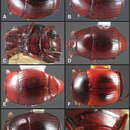Description
provided by Zookeys
Length: 1.75–2.03 mm, width: 1.47–1.62 mm; body rufescent, elongate oval, widest behind humeri, rather strongly convex, particularly near anterior third of elytra; frons and upper third of epistoma depressed at middle; sides of frontal stria nearly parallel between eyes, sinuate over antennal bases, fragmented but subcontiguous across front; labrum about 2.5× as wide as long, only very weakly emarginate apically; left mandible with weak, blunt basal tooth, right with small acute basal tooth; pronotal disk with very small punctiform prescutellar impression, ground punctation of disk very fine and sparse, with ~12 coarser punctures toward sides; marginal pronotal stria continuous behind head and along lateral margins, not descending onto hypomeron; lateral submarginal pronotal stria continuous with anterior portion across front, arching slightly anterad in pronotal corners, converging to middle of lateral margin, interrupted subbasally, with short basal fragment, pronotum weakly, narrowly depressed behind; elytra with two complete epipleural striae, outer subhumeral stria present in apical half, inner subhumeral stria absent, striae 1-4 complete, 5th stria present in apical half, sutural stria present in apical two-thirds; venter with microsculpture on most of prosternum, mesoventrite, along anterior one-fourth and at sides of metaventrite, and on 1st abdominal ventrite; prosternal keel very weakly emarginate at base, carinal striae complete, narrowing between coxae, united in slightly bulbous anterior arch, secondary carinal striae present between procoxae and prosternal gland openings; mesoventrite with anterior margin straight, marginal stria interrupted at middle; mesometaventral stria strongly arched forward, nearly to mesoventral margin, continued at sides by lateral metaventral striae to outer third of metacoxa; 1st abdominal ventrite with inner lateral stria abbreviated, outer lateral stria present only as sparse basal fragments; propygidium and basal fourth of pygidium with weakly impressed transverse microsculpture, most of pygidium lacking microsculpture; propygidial punctures small, round, separated by about twice their diameters; pygidial punctures smaller, sparser, against sparse, fine ground punctation; marginal pygidial sulcus weak, present on apical third at most, may be fragmented to absent. Male genitalia very similar to those of Operclipygus hamistrius (see Figs 57A–D, I), differing as follows: T8 with sides subparallel; S8 shorter, with apices bluntly subacuminate, ventral creases conspicuous; tegmen like that of Operclipygus arquus (see Fig. 57K) shorter, widest distinctly basad middle, with sides rounded, not as strongly narrowed to apex.
- license
- cc-by-3.0
- copyright
- Michael S. Caterino, Alexey K. Tishechkin
- bibliographic citation
- Caterino M, Tishechkin A (2013) A systematic revision of Operclipygus Marseul (Coleoptera, Histeridae, Exosternini) ZooKeys 271: 1–401
- author
- Michael S. Caterino
- author
- Alexey K. Tishechkin

